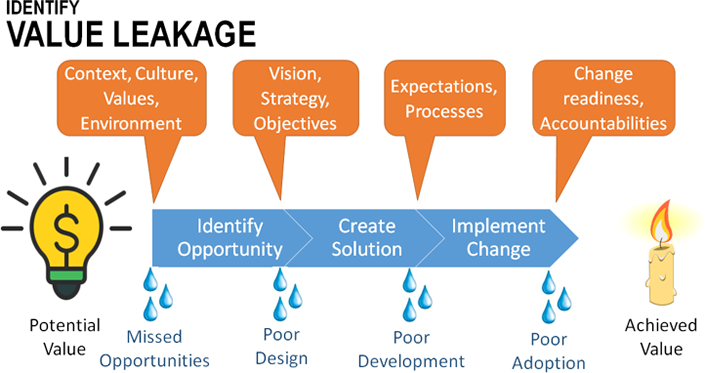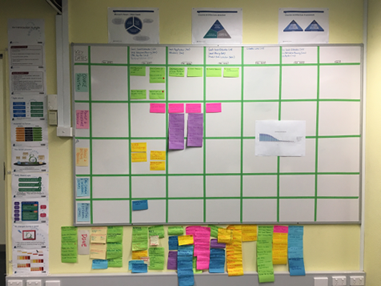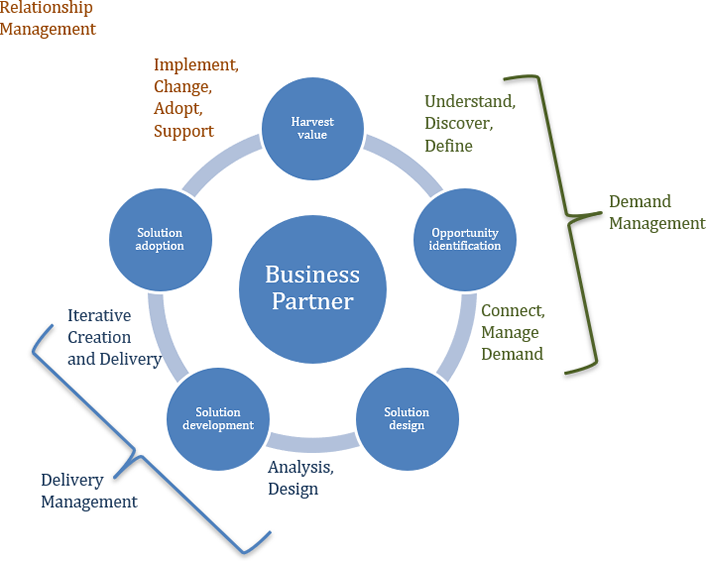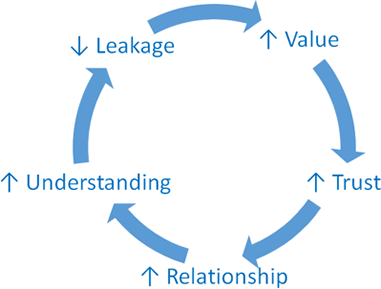By identifying and minimizing where its operations were leaking value, Monash University increased its impact and improved the perception of IT's value among its business partners.

Monash University is Australia's largest university and is ranked eighty-fourth globally, placing it among the top 1% of universities in the world. It has more than 78,000 students and supports more than 18,000 staff across four domestic and four international campuses.
Monash University's CIO Portfolio is a campus-based service that delivers IT and student communications, acting as a contact center for all current students across all faculties. The portfolio comprises more than 600 staff working across business applications, technology infrastructure, support services, and engagement capabilities. CIO Portfolio recently transformed into a modern, customer-value-centric IT function, adopting agile ways of working at scale, establishing a cloud development and hosting capability, and leading digital business transformation initiatives across the university.
Overview: Leaks Happen
Things never go to plan. You always leak value.
We always begin with a grand vision of the future. As IT professionals and leaders, we are clear and confident that what we deliver will transform our business practices and reap value for our organizations. Unfortunately, reality gets in the way, compromises are made—as are mistakes—and we inevitably deliver less than what we envisioned. This is not a disaster—it is simply our imperfect reality.
All boats leak, but not all boats sink.
If we can minimize the leakage, we will improve our performance.
Considering your overall IT workforce, technical capability, and budget, you likely have significant capacity to influence your organization. But how much value do you actually deliver? How much value do you leak along the way? If we can identify where we leak value in our operations and execution of change—and then measure it, manage it, and reduce it—we can increase our impact and influence, without the need for political maneuvering or additional funding (which is always a tough ask). And we'll also improve our business partners' perception of IT's value along the way.
The value leakage concept is not new, or terribly revolutionary, but it is nonetheless a useful lens through which to review our business. At Monash University, our efforts to reduce value leakage and improve business appreciation of organizational ICT's value have succeeded because we focus on four key goals:

- Improving relationships
- Working more closely with business partners
- Reducing our value chain length
- Improving our value delivery cycle
Value Chain Analysis
Without adoption, you will deliver shelfware.
Let's be very clear on one thing: only when the business adopts what we deliver and changes its practices accordingly does the organization realize value from our efforts. Consider your own value chain. How many stages are there between idea and business change? How many times will your initiative change hands between teams? How much is lost in translation between teams? Figure 1 illustrates key areas of value leakage.

If we don't have a deep understanding our business partners, we risk missing or under-realizing opportunities. Further, we may design solutions that aren't the best fit or that offer suboptimal build quality. We can also fall into the trap of simply delivering the solution, rather than taking our business partners through a change journey to adopt the solution. At every stage along our value chain, we risk leaking value. In addition to being inefficient and costly for the organization, such leakage diminishes enterprise IT's value in the eyes of the business.
By taking time to analyze and identify your own value stream, you can begin identifying areas in which you leak value. Some areas may be immediately obvious, while others may require measurement. Following this analysis, pick one—the area of greatest bleed—and brainstorm how you can reduce value leakage at that boundary. Then, one at a time, work through more of your value leakage areas to systematically reduce your loss. At Monash, we have found that taking an agile approach to this process has been a great vehicle for improving our value delivery and reputation.
The Agile Mindset
Deliver the least possible as quickly as you can.
With apologies to the Agile purists out there, note that I don't suggest you "adopt agile"; instead, I recommend that you simply find the bits that work for you and help you improve. If eventually you become an agile organization, great; in the meantime, you can pragmatically adopt lean practices that help you reduce value leakage.
Converge your IT and business teams.
In particular, look for opportunities to run work in parallel, converge siloed IT teams into agile (scrum) teams, and bring your business partners into the mix. If you can combine IT and business workforces, they will gain a shared understanding and ownership of the outcome and will drive improved solution design. Working together—or at least with frequent touch points (i.e., daily standups)—ensures that work is focused on the items that provide the greatest value.

Among the most valuable outcomes of converging IT and business teams are a shared journey and understanding, as well as a lack of surprises at the end. These benefits help better connect the work with the business outcomes and help the business make the operational changes required to realize the solution's true value. As Figure 2 shows, a simple Kanban wall allows the team and sponsor to come together daily to review progress and blockers and ensure that everyone is focused on priorities.
At Monash, we began by introducing agile into key strategic programs to enable excellence in education and research for the university. These programs had high visibility and showcased the approach's effectiveness. In one program, the team turned around an administrative reform program that had failed after almost three years of work and delivered a first release solution in under six months. In another institution-wide program, we partnered with a startup and released an entirely new curriculum capability in eleven weeks, ultimately converting a risk-averse executive sponsor into a champion of lean thinking. When you have non-IT senior executive selling your virtues, people listen.
Strengthen Relationships
It's all about business value. It is not about IT.
The absolute essential point in all of this is the importance of building strong relationships with your business partners. If you want the business to understand and appreciate the value of enterprise IT, you must get them involved and share the outcome. Telling them is not enough.
At Monash, we achieved this by establishing a Business Relationship Management (BRM) team that frequently goes out to meet with key business partners (faculty and divisional managers and teams). This complements existing structures, but where those structures are focused on delivery, the BRM team is focused on understanding our business partners and what represents value for them. To quote Peter Drucker, "There is nothing quite so useless as doing with great efficiency what should not be done at all." We found that even the simple gesture of going and meeting our business partners in their space, and showing a genuine desire to understand them better, has significantly improved our relationships and their opinion of enterprise IT.
Of course that alone is not enough; you then need to ensure that you give them something as well. Line up a tactical resource capability so that you can give them a quick win—something of tangible value to earn their trust. It doesn't have to be big. We have had good results simply by sending someone out to show them how to better use an application or spinning up a simple Google form. It is the gesture of showing you are genuinely interested in delivering value for them—then following through and actually delivering it—that will win their trust, not so much what you deliver.
Define Your Value Delivery Cycle
Continually improve your delivery value.
Every institution is competing in an increasingly globalized market, and everyone wants to be first to market with a new innovation. In this race, everyone is running hard, and it is not enough to run as fast as you ran yesterday. If you are not accelerating, you are falling behind. In this context, organizational IT needs to have the leanest value delivery cycle possible.
Again, this is not a complex concept. Simply take your value chain, bend it around, and connect the end to the beginning using a retro adaptor. That is, after each delivery cycle, pause and ask yourself: Which behaviors helped you improve? Which didn't? What new learnings have you captured? What will you improve on your next delivery loop?
As Figure 3 shows, our first cut looks like this:
- Demand Management
- Discover value opportunities
- Define opportunities
- Connect IT and business
- Delivery Management (iterative)
- Design solutions
- Develop solutions
- Relationship Management
- Deliver solutions
- Harvest value
- Repeat

The introduction of BRM and regular meetings with business partners has given us broader insight further upstream, so we are aware of opportunities earlier than ever before and are more prepared (reducing value leakage).
We also have introduced an initiative-on-a-page template—a simple one-page template that facilitates shared understanding and manages expectations from the outset. We use agile development and iterative delivery, with converged IT and business teams, to ensure that we design and build the optimal solution.
Lessons Learned
Understand. And deliver value.
Adopting these approaches has allowed our enterprise IT team at Monash to strengthen its relationship and reputation with business partners across the university. As a result, the organization is more aware of the value we provide, and our partners are more willing to reach out to us for advice and assistance earlier and more often.

As Figure 4 shows, the consequence of this growth has been igniting a virtuous cycle of improvement, where stronger relationships lead to better understanding and reduced value leakage, driving increased business value, which in turn builds trust, strengthens relationships, and drives the cycle further. Ultimately all of this is driving business transformation and better outcomes for everyone involved.
Although we still have more work to do, we have learned many things along the way. As I've highlighted here, four of our important learnings are:
- Focus on adoption over delivery
- Improve relationships and understand business partners
- Converge business and IT, and share outcomes
- Reduce value leakage
Where to Learn More
- Monash University
- The Scaled Agile Framework
- Agile scrum
- The Business Relationship Management Institute is a great source of advice and tools for improving business partnering.
This article is part of a set of enterprise IT resources exploring the role of digital transformation through the lens of understanding costs and value. Visit the Enterprise IT Program to find resources focused on digital transformation through the additional lenses of governance and relationship management, technology strategy, business process management, and analytics.
Lindsay MacDonald is Executive Manager of Strategy & Planning for Monash University's CIO Portfolio.
© 2019 Lindsay MacDonald. The text of this work is licensed under a Creative Commons BY 4.0 International License.
